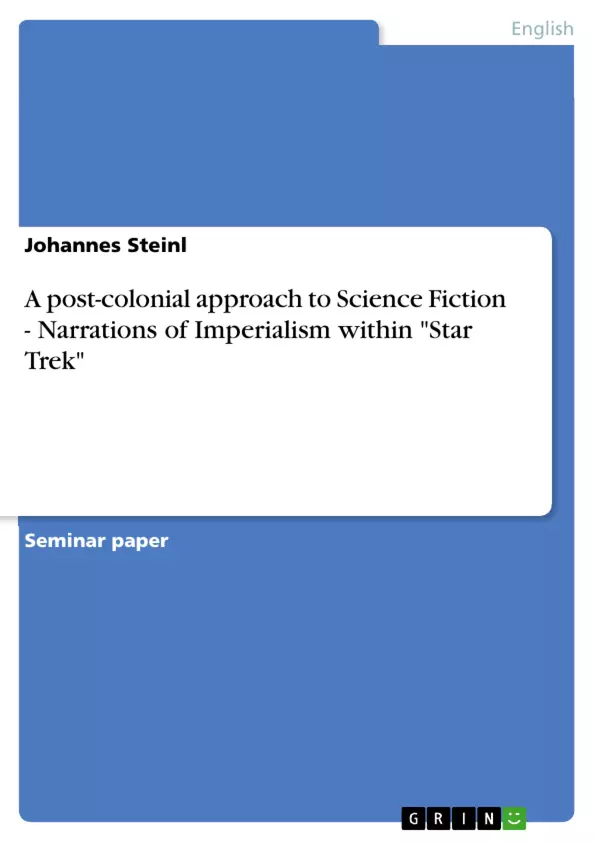"Space, the Final Frontier. These are the voyages of the starship Enterprise. Its continuing mission: to explore strange new worlds, to seek out new life and new civilizations, to boldly go, where no one has gone before."
- Opening credits of Star Trek: The Next Generation
These are the opening lines of one of the most successful franchises of popular culture: Star Trek. In 1966 when the first episode of the science-fiction series “Star Trek” The Original Series was aired on US television author and creator Gene Roddenberry would not possibly have envisioned the cultural and political impact Star Trek would have even four decades later. He nevertheless envisioned very clearly that this “trek” would take its audience to “strange new worlds […] and new civilizations”. That this would exactly fall into the field of the discourses of postcolonial studies is no mere coincidence. The opening credits very straightforwardly indicate what voyages the audience will participate in. The exploration of “strange new worlds” and “new civilizations” recalls the narratives of Imperialism and Colonialism. Accordingly Star Trek can be read as another form of travelogue. The purpose of this work is to establish the narratives of Star Trek as a travelogue in the context of imperialist and colonial discourses. Having done so, I will examine Star Trek’s standing within these discourses. My focus will be on the depiction of “the other” within Star Trek. On the basis of one episode of the TV series, Star Trek: The Next Generation I will juxtapose the argument of critics that Trek is either racist and imperialist in its conception or the depiction of a desirable Utopia.
Inhaltsverzeichnis (Table of Contents)
- Introduction
- Star Trek as a Form of Travelogue
- Exploring Post-Colonial Space
- Is Star Trek racist?
- Defining the “Other” in Star Trek
- Critical Voices
- Is Star Trek Ethnocentric?
- Narrating Colonial Encounters TNG Episode, “Code of Honor”
- Lutan’s plot and Lieutenant Yar’s Embodiment of the Female
- The Notion of Tribalism
- Ethnocentrism in ‘Code of Honor’
- The Controversy about Star Trek
Zielsetzung und Themenschwerpunkte (Objectives and Key Themes)
This work aims to examine the narratives of Star Trek as a travelogue in the context of imperialist and colonial discourses. It will analyze Star Trek's depiction of the “other” and whether the series reproduces racist and imperialist tendencies. The work will focus on the TNG episode, “Code of Honor,” and its portrayal of the “other” from a post-colonial perspective.
- Star Trek as a travelogue in the context of imperialist and colonial discourses.
- The depiction of the “other” within Star Trek.
- Star Trek's potential for reproducing racist and imperialist tendencies.
- The TNG episode, “Code of Honor,” as a case study for analyzing the portrayal of the “other.”
- The implications of Star Trek’s portrayal of the “other” from a post-colonial perspective.
Zusammenfassung der Kapitel (Chapter Summaries)
The Introduction sets the stage for the analysis by introducing the concept of Star Trek as a form of travelogue and its potential for exploring post-colonial themes. Chapter 1 explores the ways in which Star Trek draws from the narrative conventions of travel literature, particularly its historical references to the Age of Exploration and the trope of the “desert island.” Chapter 2 delves into the controversies surrounding Star Trek's portrayal of the “other.” It examines arguments that the series is racist and ethnocentric and explores Star Trek's potential for reproducing colonial attitudes. Chapter 3 analyzes the TNG episode, “Code of Honor,” as a case study of Star Trek’s depiction of the “other” through a post-colonial lens. It focuses on the Ligonians' cultural practices and their relationship with the Enterprise crew, examining the potential for stereotyping and the reproduction of colonial preconceptions.
Schlüsselwörter (Keywords)
Star Trek, travelogue, post-colonial studies, colonialism, imperialism, racism, ethnocentrism, the “other,” cultural difference, representation, narrative conventions, the “desert island,” “Code of Honor,” Ligonians, cultural stereotypes, hybridity, intercultural contact, power dynamics, utopia.
- Quote paper
- Johannes Steinl (Author), 2010, A post-colonial approach to Science Fiction - Narrations of Imperialism within "Star Trek", Munich, GRIN Verlag, https://www.grin.com/document/165105



